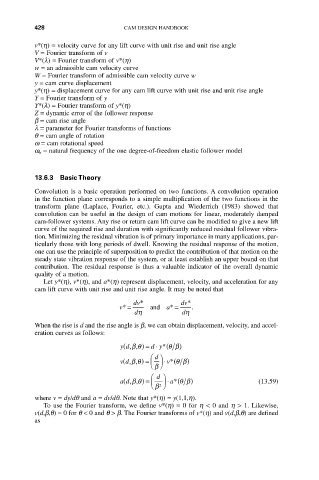Page 440 - Cam Design Handbook
P. 440
THB13 9/19/03 7:56 PM Page 428
428 CAM DESIGN HANDBOOK
v*(h) = velocity curve for any lift curve with unit rise and unit rise angle
V = Fourier transform of v
V*(l) = Fourier transform of v*(h)
w = an admissible cam velocity curve
W = Fourier transform of admissible cam velocity curve w
y = cam curve displacement
y*(h) = displacement curve for any cam lift curve with unit rise and unit rise angle
Y = Fourier transform of y
Y*(l) = Fourier transform of y*(h)
Z = dynamic error of the follower response
b = cam rise angle
l = parameter for Fourier transforms of functions
q = cam angle of rotation
w = cam rotational speed
w n = natural frequency of the one degree-of-freedom elastic follower model
13.6.3 Basic Theory
Convolution is a basic operation performed on two functions. A convolution operation
in the function plane corresponds to a simple multiplication of the two functions in the
transform plane (Laplace, Fourier, etc.). Gupta and Wiederrich (1983) showed that
convolution can be useful in the design of cam motions for linear, moderately damped
cam-follower systems. Any rise or return cam lift curve can be modified to give a new lift
curve of the required rise and duration with significantly reduced residual follower vibra-
tion. Minimizing the residual vibration is of primary importance in many applications, par-
ticularly those with long periods of dwell. Knowing the residual response of the motion,
one can use the principle of superposition to predict the contribution of that motion on the
steady state vibration response of the system, or at least establish an upper bound on that
contribution. The residual response is thus a valuable indicator of the overall dynamic
quality of a motion.
Let y*(h), v*(h), and a*(h) represent displacement, velocity, and acceleration for any
cam lift curve with unit rise and unit rise angle. It may be noted that
dv* dv*
v* = and a* = .
dh dh
When the rise is d and the rise angle is b, we can obtain displacement, velocity, and accel-
eration curves as follows:
(
d y* q b)
yd,, bq) =◊ (
Ê d ˆ
(
(
vd,, bq) = Á ˜ ◊ v* qb)
Ë b ¯
Ê d ˆ
(
(
ad,, bq) = Á ˜ ◊ a* qb) (13.59)
Ë b ¯
2
where v = dy/dq and a = dv/dq. Note that y*(h) = y(1,1,h).
To use the Fourier transform, we define v*(h) = 0 for h < 0 and h > 1. Likewise,
v(d,b,q) = 0 for q < 0 and q > b. The Fourier transforms of v*(h) and v(d,b,q) are defined
as

